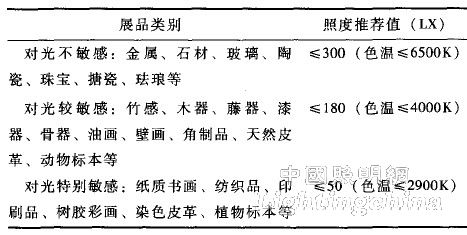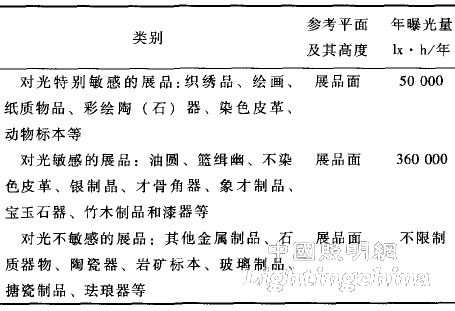1 Introduction Today's museum has become a symbol of the comprehensive strength of a country or region, and visiting museums has gradually integrated the modern lifestyle. The light environment is one of the important indicators to measure the hardware level of a museum. In order to properly keep and display the national cultural relics, we must protect it from optical radiation as much as possible; in order to create a good environment for the audience, we need We improve the level of lighting. We need to resolve and handle this contradiction as much as possible. In recent years, LED lighting technology has also begun to slowly enter the professional lighting field of various museums, providing a good way to solve and balance the contradiction between the above two aspects. This article analyzes the application of LED lighting technology in museums from several aspects. 2 Basic requirements for professional lighting systems in museums 2.1 Regulations for the professional lighting system of the museum There are three main regulations for the lighting requirements of the museums in China: (1) In 2000, the State Administration of Cultural Heritage issued the “Code for Design of Museum Lightingâ€, but in the “Code for Design of Museum Lightingâ€, only the requirements for lighting terminology, lighting quality of showrooms, protection of exhibits, and natural lighting design of showrooms were made. Roughly stated, the most important part of the lighting standard, the content of which is vacant has not yet been formulated. The "hardware requirements in the Museum Lighting Design Code" are mainly for the following: 1 Article 4.3.1 should use a light source with a color temperature less than 3300K as the illumination source. 2 Section 4.3.2 In places where high color discrimination is required for display painting, colored fabrics, multi-color exhibits, etc., a light source with a general color rendering index (Ra) of not less than 90 should be used as the illumination source. For places where the color discrimination requirements are not high, a light source having a general color rendering index of not less than 60 may be used as the illumination source. 3 Section 6.0.1 shall reduce ultraviolet and infrared radiation in the light and natural light such that the relative UV content of the source is less than 75) x W/lm. 4 Clause 6.0.2 For exhibits that are sensitive to light or particularly sensitive, in addition to limiting the illumination level to a standard value, the exposure time should be reduced. Table 6.0.2 shows the exposure of these two types of exhibits (illuminance × Time) standard. When closed, the exhibits should be in a state of no light. (2) In 1991, the Ministry of Culture promulgated the "Code for the Design of Museums". The hard parts of the lighting in the "Code for Design of Museum Buildings" are mainly the following: 1 Article 4.4.2 The lighting of the interior of the collection warehouse and the exhibits that are particularly sensitive to light shall be made of incandescent lamps and have a shading device. General lighting in the display room should use a light source with less ultraviolet light. 2 The general illuminance of the exhibition room in Article 4.4.3 shall be determined according to the type of exhibits. Refer to Table 1 for recommended values. Table 1 Recommended value of exhibit illuminance (3) In 2009, the State Administration of Quality Supervision, Inspection and Quarantine, China National Standardization Administration Committee revised the relevant technical parameters in detail on the basis of the first two specifications, and promulgated the latest national standard GB/T 23863--2009 "Museum Lighting" Design Specification, in the GB/T 23863--2009 "Museum of Architectural Design" mainly added and supplemented the following: 1 Section 4.1.5 Qualified places should be illuminated by optical fibers, light pipes, etc. 2 Article 4.1.6 The isolation and protection measures shall be provided between the lighting device and the exhibits in the showcase, and it is convenient for maintenance and management. 3 Section 4.2.3 of the display and collection of cultural relics should use no ultraviolet light source. 4 Article 7.1 For the exhibits or collections sensitive to light, except for Table 2, the annual exposure shall not exceed the requirements of Table 2. Table 2 Annual Exposure Limits for Showroom Exhibits 2.2 Objective requirements of the museum's professional lighting system Since the Museum Building Design Code was released in 1991, the Museum Lighting Design Code was released in 2000. It has been more than 10 years since the beginning of the year. The standard parameter range is relatively large, and the effect of lighting and cultural relic protection is not very good in actual operation. The promulgation of GB/T 23863--2009 "Museum of Architectural Design of the Museum" has revised and supplemented the former, but with the development of the times, it has slowly failed to keep up with the trend of scientific and technological development, and it is necessary to revise more precise and detailed parameters. Standards and specifications. The museum showroom now has several new features in terms of lighting system requirements: (1) Provide more accurate illumination and color temperature standards according to the different attributes of the displayed artifacts. (2) No damage or secondary disasters are allowed on the displayed cultural relics. (3) Must have good intelligent control ability and good function expansion capability. (4) Must have certain energy-saving green environmental performance. 3 LED lighting technology and museum's existing lighting technology comparison 3.1 light source color rendering According to the requirements of 4.3.2 of the Museum Lighting Design Code promulgated by the State Administration of Cultural Heritage: in places where paintings, colored fabrics, multi-color exhibits and other requirements for color discrimination are required, the general color rendering index (Ra) should be no less than 90. The light source is used as an illumination source. For places where the color discrimination requirements are not high, a light source having a general color rendering index of not less than 60 may be used as the illumination source. There is no problem with the halogen light source products used in the museum's existing lighting technology. In the initial stage of LED lighting technology, this is a big problem that plagues LED lighting products into the museum, because the color rendering of LED lighting products is not very good at the beginning of development, which will make the exhibits of the museum produce more obvious color. The good phenomenon, with the development of science and technology in the past two years, has a high color rendering LED lighting products, which can meet the needs of the museum's exhibition, the general color rendering index can reach more than 90 standards, good products reach 95, It has been completely replaced by halogen light source products for museum artifact display lighting. 3.2 Protection of cultural relics The damage caused by lighting equipment to cultural relics at work mainly includes ultraviolet radiation hazard, infrared radiation hazard and photochemical reaction hazard. Ultraviolet radiation will cause oxidation and fading of the exhibits. The thermal effect of infrared radiation will cause the surface temperature of the exhibit to be too high, and the surface material will be damaged with a certain photochemical reaction damage. According to the requirements of Article 6.1 of the Museum Lighting Design Code promulgated by the State Administration of Cultural Heritage, the ultraviolet radiation and infrared radiation in the light and natural light should be reduced so that the relative ultraviolet content of the light source is less than 75 w/1 m. For the halogen light source products used in the museum's existing lighting technology, the solution is to install an anti-ultraviolet radiation filter on the light source itself and the luminaire to control the non-photosensitive substance <75 I~W/lm (density 0.05 btW/em) Photosensitive substances <10 I, zW / lm (density 0.05 ~ W / em), and the installation of professional insulation filters. This will significantly increase the volume of the luminaire, which is not conducive to installation and maintenance, and has an adverse effect on the overall aesthetics of the luminaire. Halogen light source products have only reduced the damage to display cultural relics after adding anti-ultraviolet radiation and infrared radiation filters, and it is impossible to completely cure them. The reason is that harmful light has a comprehensive and multi-faceted harm to cultural relics exhibits. The result of the action. For LED lighting technology products, the damage to cultural relics exhibits is much less. In terms of anti-ultraviolet radiation hazard, LED lighting technology has a great performance advantage over conventional lighting, because the light source using LED lighting technology can have no ultraviolet light in its spectrum, so it can be installed safely during use, and it is not needed in the lamp. A filter is installed to minimize the UV radiation hazard. In terms of anti-infrared radiation, LED lighting is also better than conventional lighting products. The light source using LED lighting technology does not generate infrared radiation, which can effectively control the thermal effect and the secondary photochemical reaction hazard, and prevent the surface material of the exhibit from being damaged, discolored, and peeled off. Cracking. There will also be great savings in terms of funding, because the anti-ultraviolet radiation filter and the professional insulation filter are purchased on the basis of the purchase of the lamp, and the cost is relatively expensive. 
